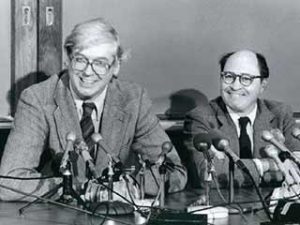Johns Hopkins UniversityEst. 1876
America’s First Research University
Rising last spoke with Jeremy Nathans, professor of molecular biology and genetics, in 2016 — just after he helped to launch the Hamilton “Ham” Smith Award for Innovative Research. The award, which recognizes promising young scientists in Johns Hopkins’ Institute for Basic Biomedical Sciences, provides flexible funding for their research — no grant-writing required and no strings attached. Jie Xiao, an associate professor in the department of biophysics and biophysical chemistry, received the first award, and four others have been honored since then.

Jeremy continues to play a large role in fundraising for the award, and it became a family affair as his mother, Joanne Nathans, has joined him in the effort. Last year, Joanne sold the 1978 Nobel medal won by her husband and Jeremy’s father, Daniel Nathans, with help from the internation auction house Christie’s. The family then donated the proceeds to the Hamilton Smith Award. Daniel received the 1978 Nobel Prize in Medicine alongside Smith and Werner Arber, a Swiss scientist, for their research on restriction enzymes.
Jeremy and Joanne spoke about the auction, the medal, and why the Hamilton Smith Award means so much to their family in this edition of What Happened Next?
Joanne: Dan received the award in 1978, and it came with a gold medal. But the medal has been sitting in a safe deposit box ever since, not doing any good for anybody. And I was thinking — I’ve got three children and seven grandchildren. When I die, who’s going to get it? Who will want it? Who on earth wants to have to make that decision? Auctioning off the medal and making sure all the proceeds go to the Ham Smith Award would be a good way to solve the problem. This is a brief chapter with a happy ending.
Jeremy: Dan and Ham were colleagues here for 30 years. They were very close friends. Ham’s discovery of restriction enzymes was critical for my father’s subsequent application of them. Basically, my father had an idea of how to use them for the research he was doing about virus structure. Ham generously gave him samples of the enzyme. There was no requirement attached to be a collaborator or a co-author; Ham just was very generous. That’s the kind of collegiality we want to nurture here and we commemorate and remember that with this award. It also honors Ham’s and my father’s spirit of adventure, the spirit of discovery you need if you’re going to make a really important scientific discovery. It’s a bit like sailing across the ocean in a boat — you don’t know what you’re going to bump into.
Joanne: The medal, of course, is for Dan’s work. I think this [the Hamilton Smith Award] is something he would appreciate — and perhaps other people will decide to add to it. It calls attention to the fact that there are many early-career faculty members who are eager to make a contribution to humanity. They’re doing good work, and we want to recognize that.
Jeremy: This kind of funding is very valuable in that there are no strings attached. The recipients don’t need to write a grant to buy a piece of equipment or get a particular idea off the ground; if it can fit in the amount of money we have given them, they can spend it. They can do an experiment they wouldn’t otherwise be able to do. There’s also a psychological effect. It’s a message from their senior peers — the selection committee is made up of one full professor from each of the IBBS departments — of congratulations. It shows that we are confident in their abilities and their creativity. That aspect is just as important as the money.
Jeremy: Most of the great scientific breakthroughs have come from young scientists. For example, almost all Nobel prizes have been given for work that was started early in a scientist’s career. It’s almost always people in their 20s and 30s who are doing the groundbreaking, revolutionary work. This pattern argues that we should be supporting scientists at a time when they are at their most creative career stage, and they are thinking out of the box. Unfortunately, there’s a demographic trend of fewer federal biomedical research dollars going to younger scientists. The result is that the younger scientists are getting squeezed. I think the Ham Smith Award is helping to move the system in the right direction by injecting some funds where they will do the most good.
2018: Daniel O’Connor, assistant professor, Department of Neuroscience
2017: Takanari Inoue, associate professor, Department of Cell Biology
2016: Hiromi Sesaki, associate professor, Department of Cell Biology and Marshall G. Hussain Shuler, assistant professor, Department of Neuroscience
2015: Jie Xiao, associate professor, Department of Biophysics and Biophysical Chemistry
Interested in supporting funds that advance young medical researchers at Hopkins?
Topics: Faculty and Staff, Friends of Johns Hopkins Medicine, Johns Hopkins Medicine, Fuel Discovery, Promote and Protect Health